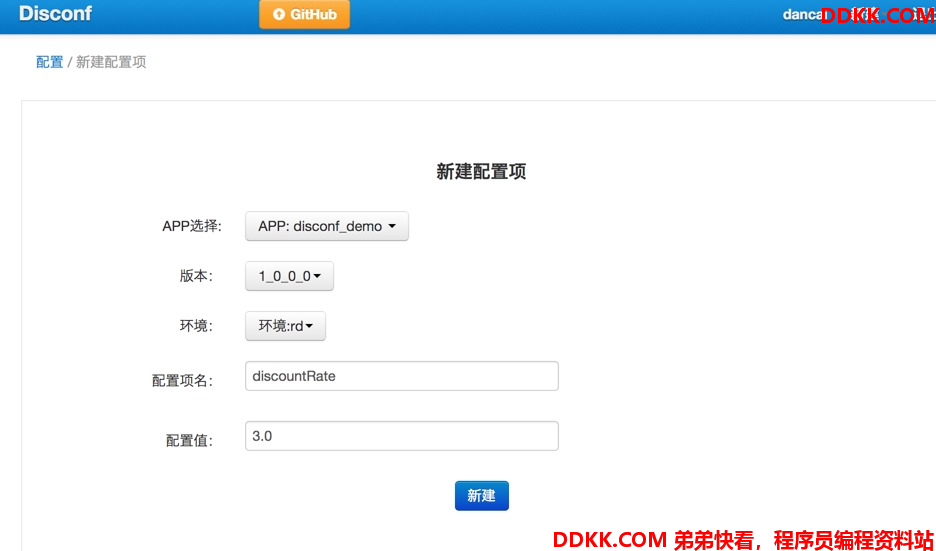在Tutorial 1 里,
我们实现了一个简单的Redis服务程序,它使用注解式的分布式配置进行管理,此Redis的配置文件存储在分布式服务器 disconf-web 上。
那如果你的配置只是一个变量,不是配置文件,怎么办?还能实现分布式配置吗?
答案当然是肯定的!
Disconf支持配置项(配置项是指 一个类的某个域变量)的分布式化。
这里以disconf-demo 某个程序片段为例,详细介绍了 分布式的配置项 的简单示例程序。
在这里,我们将分两种情况来进行演示:
1、 配置项在某个配置类里:外部程序通过配置类的get***方法获取;
2、 配置项在某个Service类里Service通过本身类的的get***方法获取;
对于这两种方式,Disconf的后台实现方式上有所不同。这里不会讲述具体原因。但是Disconf做到了兼容性,以上两种方式均支持。
3.1. 配置类里的配置项
第一步:撰写 配置项类
这里假设有一个金融系数类,它有一个折扣率变量。
package com.example.disconf.demo.config;
import org.springframework.beans.factory.annotation.Value;
import org.springframework.stereotype.Service;
import com.baidu.disconf.client.common.annotations.DisconfFile;
import com.baidu.disconf.client.common.annotations.DisconfFileItem;
import com.baidu.disconf.client.common.annotations.DisconfItem;
/**
* 金融系数文件
*
**/
@Service
@DisconfFile(filename = "coefficients.properties")
public class Coefficients {
public static final String key = "discountRate";
@Value(value = "2.0d")
private Double discount;
/**
* 折扣率,分布式配置
*
* @return
*/
@DisconfItem(key = key)
public Double getDiscount() {
return discount;
}
public void setDiscount(Double discount) {
this.discount = discount;
}
}
具体步骤是:
1、 编写Coefficients类,添加域discount;
2、 用Eclipse为域discount添加get&set方法;
3、 为get方法添加注解@DisconfItem(key=key),这里的key是分布式配置项的标识,这里是discountRate;
4、 此类必须是JavaBean,Spring托管的,且“scope”都必须是singleton的;
5、可以使用@Value为它设置一个默认值;
第二步:使用此分布式配置项
撰写一个Service类,它使用 第二步里的 discountRate 变量,完整的类是:
package com.example.disconf.demo.service;
import org.slf4j.Logger;
import org.slf4j.LoggerFactory;
import org.springframework.beans.factory.annotation.Autowired;
import org.springframework.beans.factory.annotation.Value;
import org.springframework.stereotype.Service;
import com.baidu.disconf.client.common.annotations.DisconfItem;
import com.example.disconf.demo.config.Coefficients;
/**
* 金融宝服务,计算一天赚多少钱
*
* @author liaoqiqi
* @version 2022-5-16
*/
@Service
public class BaoBaoService {
protected static final Logger LOGGER = LoggerFactory
.getLogger(BaoBaoService.class);
@Autowired
private Coefficients coefficients;
/**
*
*
* @return
*/
public double calcMoney() {
return 10000 * coefficients.getDiscount();
}
}
calcMoney()会调用 coefficients.getDiscount() 获取折扣率 来计算 真正的money.
第三步:配置项更新回调类
当配置项更新时,你的服务程序自动就会获取最新的配置项数据(不需要写回调函数,因为这里不像Redis这种较“重”的服务,这里的配置是实时生效的)。
但是,如果当你的配置项更新时,配置项本身被更新后,可能还会其它类依赖此配置项的更新,那么,你需要撰写一个回调类来获取此通知。
为了简单,这里我们以 Tutorial 2 里的 SimpleRedisServiceUpdateCallback 类 为基础,进行扩展。
假设,当此配置项被更新时,Redis也需要重新被reload,那么,你可以这样来改写 SimpleRedisServiceUpdateCallback 类,完整的代码如下:
package com.example.disconf.demo.service.callbacks;
import org.slf4j.Logger;
import org.slf4j.LoggerFactory;
import org.springframework.beans.factory.annotation.Autowired;
import org.springframework.stereotype.Service;
import com.baidu.disconf.client.common.annotations.DisconfUpdateService;
import com.baidu.disconf.client.common.update.IDisconfUpdate;
import com.example.disconf.demo.config.Coefficients;
import com.example.disconf.demo.config.JedisConfig;
/**
* 更新Redis配置时的回调函数
*
* @author liaoqiqi
* @version 2022-6-17
*/
@Service
@DisconfUpdateService(classes = { JedisConfig.class }, itemKeys = { Coefficients.key })
public class SimpleRedisServiceUpdateCallback implements IDisconfUpdate {
protected static final Logger LOGGER = LoggerFactory
.getLogger(SimpleRedisServiceUpdateCallback.class);
@Autowired
private SimpleRedisService simpleRedisService;
/**
*
*/
public void reload() throws Exception {
simpleRedisService.changeJedis();
}
}
这里通过为注解 @DisconfUpdateService 添加一个 itemKeys: Coefficients.key ,就实现了配置项更新的通知。怎么样?是不是很强大?
第四步:在disconf-web上上传配置
上传方式是先在首页点击 新建配置项

然后新建就行啦

完结
通过几行简单的配置,分布式配置项 就这样添加到你的应用程序里了。
3.2. Service类的配置项
在上一节里,我们阐述了如何在 配置项类 里添加一个配置项的方法。
在本节里,我们将在上一部分的基础上,阐述如何实现 不创建配置项类 就可以 实现 分布式配置项 的方法。
准备
在分布式配置服务器 disconf-web 上添加 moneyInvest 和 discountRate 配置项值。
第一步:撰写 含有 配置项 的Service类
在上一节里,我们撰写了一个 Coefficients.java 类,它含有 分布式配置项 discountRate,BaoBaoService.java 则是一个使用 discountRate 的服务。BaoBaoService.java 在计算(calcMoney)时,使用了固定值 10000.
在本节里,我们 将 10000 这个值动态化,标注为分布式配置项。
完整的类是:
package com.example.disconf.demo.service;
import org.slf4j.Logger;
import org.slf4j.LoggerFactory;
import org.springframework.beans.factory.annotation.Autowired;
import org.springframework.beans.factory.annotation.Value;
import org.springframework.stereotype.Service;
import com.baidu.disconf.client.common.annotations.DisconfItem;
import com.example.disconf.demo.config.Coefficients;
/**
*
* @author liaoqiqi
* @version 2022-5-16
*/
@Service
public class BaoBaoService {
protected static final Logger LOGGER = LoggerFactory
.getLogger(BaoBaoService.class);
public static final String key = "moneyInvest";
private Double moneyInvest = 1000d;
@Autowired
private Coefficients coefficients;
/**
*
* @return
*/
public double calcMoney() {
return coefficients.getDiscount()
* getMoneyInvest();
}
/**
* 投资的钱,分布式配置 <br/>
* <br/>
* 这里切面无法生效,因为SpringAOP不支持。<br/>
* 但是这里还是正确的,因为我们会将值注入到Bean的值里.
*
* @return
*/
@DisconfItem(key = key)
public Double getMoneyInvest() {
return moneyInvest;
}
public void setMoneyInvest(Double moneyInvest) {
this.moneyInvest = moneyInvest;
}
}
具体实现步骤是:
1、 添加域moneyInvest,并使用Eclipse自动生成get&set方法;
2、 为get方法添加@DisconfItem注解,并添加key为moneyInvest;
3、 在函数calcMoney()里调用本身类的getMoneyInvest()方法;
4、 此类必须是JavaBean,Spring托管的,且“scope”都必须是singleton的;
第二步:在disconf-web上上传配置
这里不再赘述。
完结
只需要上面一步,就完成了分布式配置项。
配置更新也是实时的,不需要写回调函数。
service类的配置项 其实和 配置项类的配置项 撰写方法 差不多。它的好处是不需要再新建一个配置项类。
版权声明:「DDKK.COM 弟弟快看,程序员编程资料站」本站文章,版权归原作者所有
来源:https://disconf.readthedocs.io/zh_CN/latest/index.html